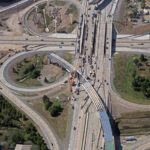- Company: Weaver Bailey Contractors Inc.
- Industry: Transportation
- Location: Little Rock, Arkansas
- Expected Completion Date: August 4, 2015
- Project Website
Over the past 8 years the I-430/ I-630 Interchange has underwent 3 phases of construction nearing approximately $160 million dollars worth of renovations. The first of the three phases started in January 2009, constructing an additional I-630 west to I-430 north lane. The second phase involved lengthening the I-430 bridge over I-630. And the third and final phase constructed 5 bridges; 07189 Bridge (Bridge over Shackleford Road) 07190 Bridge (South to East) 07191 Bridge (North to East) 07192 Bridge (West to South) and 07193 Bridge (Baptist Health Drive), 12 MSE Walls and approximately 150,000 square yards of 13” continuously reinforced pavement. The project was joint ventured between Weaver Bailey Contractors Inc. and Manhattan Road & Bridge. Beginning in December 2010 the 5 year project was deemed substantially completed on August 4, 2015. The original contract amount was $78,123,925.30 with 376 working days. After all the projects change orders and impacts, to date the contract amount totals $90,451,753.18 with 631 working days.
What impact does this project have on America?
To accommodate approximately 200,000 vehicles that travel this thoroughfare every day the Arkansas State Highway and Transportation Department knew the approximately 150,000 square yards of 13” Continuously Reinforced Concrete Pavement would serve well in having a low maintenance product that would last through the ages. From the structural strength of 5 bridges, to the aesthetically pleasing appearance of the MSE wall panels that symbolize the natural state. The interchange will aid in functionality and design to alleviate congestion and provide a safe commute for the traveling public. At the time of award, the I-430/I-630 (Phase III) “Big Rock Interchange” was declared the largest highway contract in the state. From its functionality to its beauty, this interchange is now a staple to the Little Rock metro area.
What interesting obstacles or unusual circumstances did you overcome to complete the project?
While we were performing the unclassified excavation on the Baptist Health direct ramp we encountered a large vein of rock. We exposed the rock formation and began measuring the elevations/ offsets to see if the structure would impede any future construction. Upon our discovery the rock formation would not obstruct the direct ramp. Therefore, Weaver Bailey made request to the owner to leave the monumental stone in place. After much discussion, the department came to the conclusion that by leaving the stone in place it would save the department time and money from added change order costs to demo the large stone. A few months later the interchange was deemed the name “The Big Rock Interchange”.
What dangers and risks did you encounter, and describe any extraordinary methods used to keep workers safe?
With the large volume of traffic traveling the project daily, the owner and joint venture had to engineer traffic sequences that would allow further progression of the project while still maintaining a safe working environment for employees and traveling public. One example of how we were able to maintain workers safety was hanging the steel girder units over I-430 for Bridges 07190 and 07192. After numerous task force meetings we were able to design several traffic configuration that would allow the joint venture to hang the girder units within a 2 week period without delay to the traveling public. We were able to keep our employees safe by creating as much distance between the traveling public and our workers.
How did you leverage new technologies to work faster and reduce waste?
By utilizing HeavyBid and HeavyJob we were able to set up crews and equipment to closely monitor labor and equipment costs. Additionally, since we have implemented heavy job in the field our supervisors can work closer with the office to track the needed materials and equipment to stay on schedule.
One way we were able to reduce waste was having the ability to re-use materials from current projects. Weaver Bailey had to excavate approximately 180,000 yds of unclassified excavation from the Baptist Direct Ramp. Shortly after being awarded the Phase III contract, Weaver Bailey bid on and was awarded the 061202 project (Highway 5 Widening). The 061202 project required approximately 71,000 cy of compacted embankment to raise the roadway elevation. With the projects being within 10 miles of one another we were able to be compensated for the unclassified excavation from the Baptist Cut and then haul the same material to the 061202 project and get paid compacted embankment.








